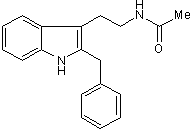All AbMole products are for research use only, cannot be used for human consumption.

Luzindole (N-0774) is a selective competitive melatonin MT1/MT2 antagonist with Ki values of 10.2 and 158 nM for human MT2 and MT1, respectively. Luzindole inhibits experimental autoimmune encephalomyelitis and exerts antidepressant-like activity. Luzindole (5-10 μg/ml) inhibits antigen-specific proliferation of the MBP-reactive LV-4 T cell line.
In Twenty-three- to 12-week-old (SJL X PL/J ) F1 mice, Luzindole (30 mg/kg; i.p.; days 0-5) suppresses experimental autoimmune encephalomyelitis.
| Molecular Weight | 292.38 |
| Formula | C19H20N2O |
| CAS Number | 117946-91-5 |
| Solubility (25°C) | DMSO 90 mg/mL |
| Storage |
Powder -20°C 3 years ; 4°C 2 years In solvent -80°C 6 months ; -20°C 1 month |
| Related Melatonin Receptor Products |
|---|
| DH97
DH97 is a potent and selective antagonist of MT2 melatonin receptor, with a pKi of 8.03 for human MT2. |
| 8-M-PDOT
8-M-PDOT (AH-002) is a selective melatonin MT2 receptor agonist. |
| 6-Chloromelatonin
6-Chloromelatonin is a potent melatonin receptor agonist with greater metabolic stability than melatonin. |
| Melatonin-d4
Melatonin-d4 |
| Piromelatine
Piromelatine (Neu-P11) is a melatonin MT1/MT2 receptor agonist, serotonin 5-HT1A/5-HT1D agonist, and serotonin 5-HT2B antagonist. Piromelatine (Neu-P11) possesses sleep promoting, analgesic, anti-neurodegenerative, anxiolytic and antidepressant potentials. Piromelatine (Neu-P11) also possesses pain-related P2X3, TRPV1, and Nav1.7 channel-inhibition capacities. |
All AbMole products are for research use only, cannot be used for human consumption or veterinary use. We do not provide products or services to individuals. Please comply with the intended use and do not use AbMole products for any other purpose.


Products are for research use only. Not for human use. We do not sell to patients.
© Copyright 2010-2024 AbMole BioScience. All Rights Reserved.
